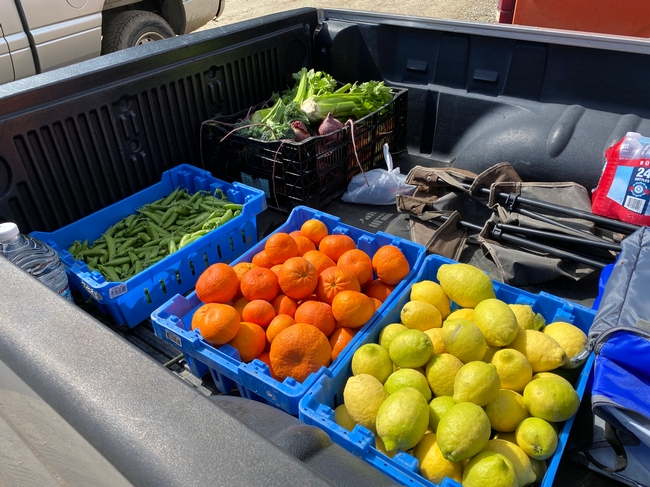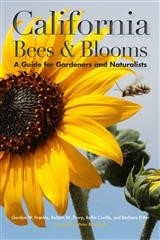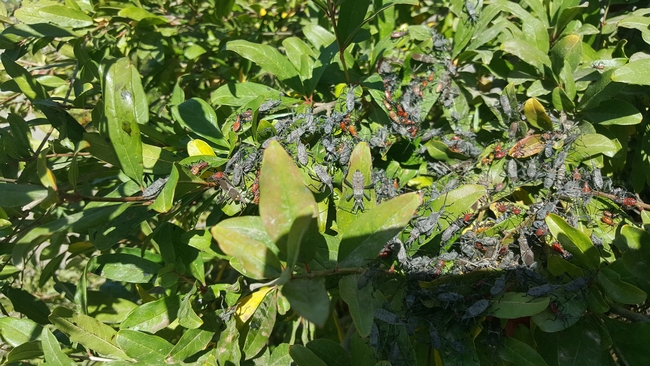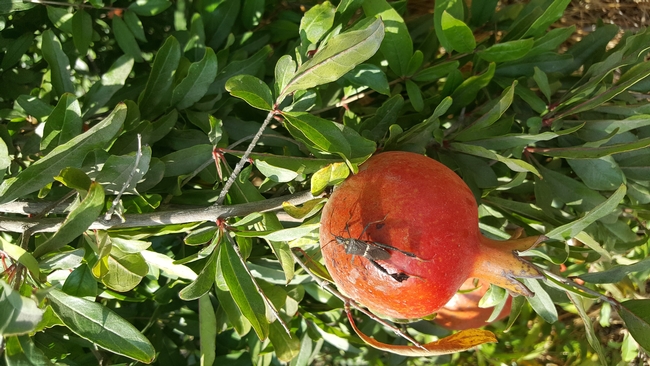
Posts Tagged: gardens
UC HAREC Donates Fruits and Vegetables to Food Forward and Ventura Schools
Nearly two tons of fruit and vegetables grown at UC's Hansen Agricultural Research and Extension Center (HAREC) in Santa Paula have been donated to Food Forward and the Ventura Unified School District (VUSD), destined for children and families.
Some of the vegetables – planted by volunteers and farm staff - became available when UC HAREC's farm field trips were canceled due to COVID-19. Other vegetables were harvested from the student farm located at HAREC, a partnership with VUSD and the city of Ventura. Kale and lettuce at the student farm were planted by youth from DATA and Montalvo schools.
Every fall and spring, volunteers from the UC Master Gardener program propagate seedlings for schools, bundling them into variety packs of vegetables and herbs, which are given to schools with gardens. Because of COVID-19, plants were given to schools for direct distribution to families. Ventura Unified School District staff partnering in this effort include Kara Muniz, Director of Food and Nutrition Services; Ashely Parrish Decker, Nutrition Educator, who runs the Student Farm; and Alise Echles, RDN.
Additional fruit and vegetables were harvested from HAREC's citrus demonstration area, the site's educational gardens and the farm grounds.
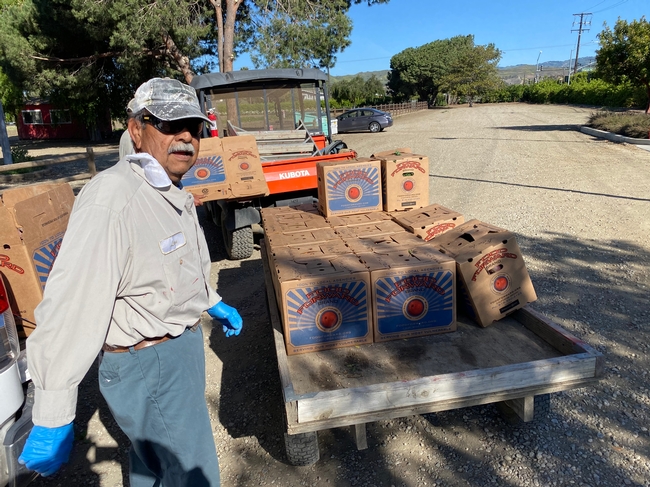
UCCE's education program manager Susana Bruzzone-Miller said, “We are saddened that spring field trip season is cancelled and miss the sound of children delighting in harvesting, sometimes for the very first time. But, it warms my heart that our field trip garden can help feed so many families in need.”
John Antongiovanni, farm manager, worked with the farm staff to organize the harvest. He said, “Working together during this difficult time is very rewarding.”
Food Forward is a gleaning organization that helps residents turn the surplus produce grown on their property into a nutritious food source for local communities. Rick Nahmias, founder and executive director, indicated that the Food Forward Backyard Harvest team remains active, and may be reached via phone at 805.630.2728 or email.

IMG 20200420 153035966 HDR
Bees to Look Out For
Nearly 1600 species of native bees can be found in California's rich ecosystems; this colorful pocket-sized card set will help you identify 24 of the most common bees found in urban gardens and landscapes.
Using this card set, you'll be able to identify bees on the wing to the genus level. Included for each featured bee are color photographs, a general description of appearance, the distribution and richness, flight season, nesting habits, floral hosts, and how each transports pollen.
Also included is a brief description and illustration of the anatomy of a bee, a glossary, bibliography, and online resources so you can delve deeper into the lives of these fascinating social insects.
Designed as a companion to the book California Bees and Blooms. This 3-1/2" x 5-1/4" card set is spiral bound and printed on sturdy laminated paper to hold up to rough service in the field.
CB & B also has lists of plants attractive to different bee species
Get this and "California Bees and Blooms" at :
http://anrcatalog.ucanr.edu/Details.aspx?itemNo=3552
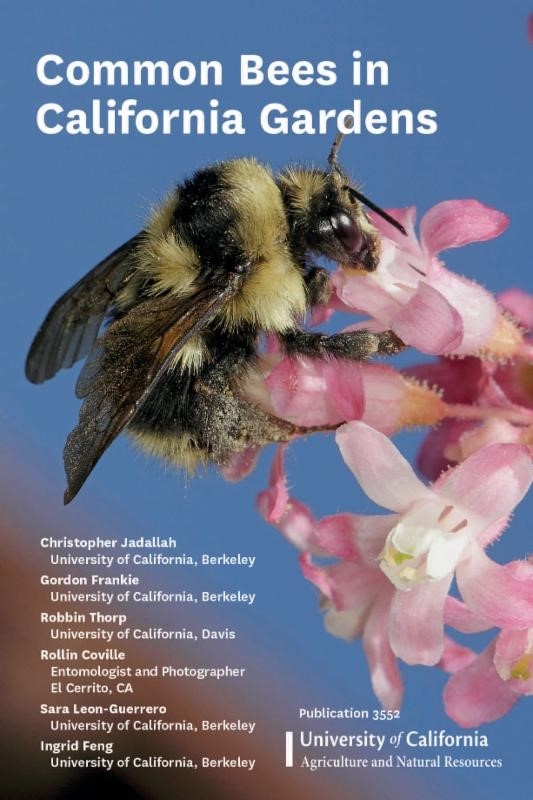
bees book frankie
Leaffooted Bug Alert
0University of California Cooperative Extension Area-wide IPM Advisor, Kearney Agricultural Research and Extension Center, Parlier, CA
Leaffooted Bug Populations in Ventura County - 2017
Cold winter temperatures can reduce populations of leaffooted bug, Leptoglossus zonatus (Dallas), by ~50 to 80%. But unfortunately, it takes a cold year much like occurred in January of 2007 when daytime temperatures remained low and nighttime temperatures reached about 20° F for several hours. In other words, ouch for the citrus crop. Fall and winter temperatures of 2016 / 2017 were ideal for leaffooted bug and the 2017 growing season started out with large populations. I need to add that we do not fully understand if the wet winter positively affected populations - it certainly did not have a negative impact. Moreover, it appears that leaffooted bug populations going into later 2017 will be very large.
Monitoring and managing leaffooted bug presents an IPM challenge. In the fall between September and mid-November, the species produces a full generation; certainly, on pomegranate and although I have not observed it, also on desert willow. In most years, adults move from those host plants by late December to protected overwintering sites such as Mediterranean fan palm and Italian cypress trees; and perhaps citrus. In early March leaffooted bug leave overwintering sites to feed on what happens to be available at the time. In the San Joaquin Valley and the Sacramento Valley region it is almonds and pistachio. In other parts of California, where those nut crops are not available, citrus may be an important host crop. In Louisiana, for instance L. zonatus can cause considerable economic damage on satsuma mandarins, however in California the species has not been reported as a serious pest on any of the citrus cultivars.
The IPM challenge is that we do not have an effective monitoring tool to detect the bug when they leave overwintering sites. And moreover, once leaffooted bug is detected, no economic threshold exists , and pyrethroids offer the best management option – not necessarily the best IPM option.
Given the importance of pomegranate in the life cycle of leaffooted bug, PCAs and growers need to concentrate monitoring efforts on that crop during September through October, especially focusing on unmanaged orchards and hedgerows. If populations are found they will consist mainly of immature stages and there are two management options, clothianidin and pyrethrins. The caveat is that those compounds have only contact activity; coverage must be good and the insecticides will likely not have a great impact on adults because they will spook and fly away before being sprayed. Two organic compounds, pyrethrin (PyGanic) and Beauveria bassiana Strain GHA (BotaniGard) can also be effective. But again, those compounds have no residual activity so the spray must contact the bugs to be effective.
Insecticide use should occur only if monitoring indicates the presence of leaffooted bug and/or its feeding damage. Apply insecticides only after considering the potential risks of the compound to beneficial organisms, including bees and biological control agents, and to air or water quality. For more information on these topics please consult the UC IPM Pest Management Guidelines for Almonds at http://ucipm.ucanr.edu > Agricultural pests > Almond
(Ben: This insect became prominent in Ventura in 2015. Kris was minding his own business when he saw this bug traveling at 50 mph down the road.
//ucanr.edu/blogs/blogcore/postdetail.cfm?postnum=19184)
|
Fig. 1. Aggregation of leaffooted by on pomegranate in early October of 2016. The aggregation is comprised mostly of fifth instar. |
|
Fig. 2. Adult leaffooted bug on pomegranate in Ventura County, September 8, 2017. |
Teacher Workshop at the Center
Atlanta-based Captain Planet Foundation (CPF) has run a school garden program in the Metro Atlanta area since 2009. Last Friday, the nonprofit took the program on the road and delivered one of the first teacher workshops outside their home base. Led by...
Rose Hayden-Smith Named Bradford-Rominger Award Winner

The annual award is given to a recipient whose dedication to the field of agricultural sustainability best reflects the legacy of Charlie Rominger and Eric Bradford, academics known for their passionate comittment to agriculture. Rose has consistently demostrated such passion and enthusiasm for her work in this area and we congratulate Rose on another well-deserved honor.
To read the UC ANR blog post about Rose's contribution and learn more about the award, please click here.

